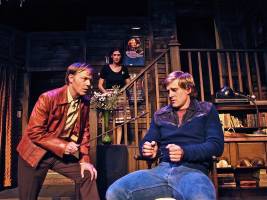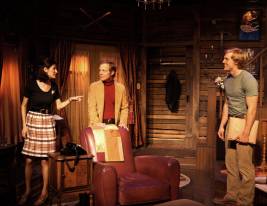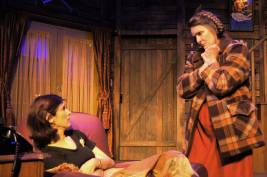
Ira Levin’s spine-tingling thriller Deathtrap is back, and while it’s not in fact “the first Los Angeles production in 20 years” as proclaimed in press materials (San Pedro’s Little Fish Theatre revived it terrifically in 2009), its arrival at the Davidson/Valentini Theatre is exciting news indeed, particularly since the Ken Sawyer-directed production is a prime example of L.A. theater at its all-around finest.
 To this day the longest running thriller in Broadway history, Deathtrap riveted New York audiences (and tickled them to death with its multitude of plot twists and turns) for a record-breaking four years before director Sydney Lumet brought it to the silver screen in 1982.
To this day the longest running thriller in Broadway history, Deathtrap riveted New York audiences (and tickled them to death with its multitude of plot twists and turns) for a record-breaking four years before director Sydney Lumet brought it to the silver screen in 1982.
For those who’ve seen neither play nor film, as little as possible will be revealed in this review. Still, here’s a bit of a preview to pique interest in a production that no thriller lover should even dream of missing:
Our hero is Sidney Bruhl (Brian Foyster), author of the smash hit Broadway thriller The Murder Game—and of the four flops that followed it. He and wife Myra (Cynthia Gravinese) are currently living a quiet life in Westport, Connecticut, where Bruhl is trying in vain to write hit #2, the perfect five-character, one-set, two-act thriller, a play in fact just like the one we’re watching at the Davidson/Valentini. (This bit of self-reference is only one of Deathtrap’s countless winks at the audience.)
Sidney has recently received a play in the mail, coincidently titled Deathtrap, written by a former student of his. He tells Myra that since Deathtrap is precisely the play he’s been trying to write for lo these many flops, perhaps it might not be such a bad idea to murder its author, poor Clifford Anderson (Burt Grinstead), and present the play as his own.
Since Deathtrap is set in the pre-Microsoft 1970s, there are only two copies of Clifford’s play in existence, the original and the carbon which he has sent to Sidney. (Conveniently, the fledgling writer says he’s waiting for Sidney’s suggestions to Xerox additional copies.) All Sidney has to do, should he decide to go through with his deadly intentions, is send the talented would-be playwright to his maker, and presto, Sidney Bruhl will have another smash hit on his hands.
Complicating matters for Sidney is next-door psychic Helga ten Dorp (Elizabeth Herron), who senses “pain and death” in the writer’s study, particularly when she sees the large collection of daggers, guns, battle-axes, maces, and crossbows decorating the study walls, mementos of Sidney’s previous plays. The five-character cast is completed by Porter Milgrim (Stephen Mendillo), Sidney’s lawyer, who pops in later in the play.
 Like any mystery thriller worth its salt, Deathtrap keeps its audience guessing about what will happen next. Like any great mystery thriller, it makes sure that its audience will be wrong 99% of the time. Lucky are the Deathtrap virgins who will be seeing the play for the first time. Almost equally fortunate are those rediscovering Deathtrap’s many unexpected plot twists, or watching for clues and red herrings with the wisdom of foreknowledge. Nostalgia lovers can also delight in the play’s many then contemporary pop culture references (e.g. Helga’s upcoming appearance on The Merv Griffin Show), which now make it a perfect period piece.
Like any mystery thriller worth its salt, Deathtrap keeps its audience guessing about what will happen next. Like any great mystery thriller, it makes sure that its audience will be wrong 99% of the time. Lucky are the Deathtrap virgins who will be seeing the play for the first time. Almost equally fortunate are those rediscovering Deathtrap’s many unexpected plot twists, or watching for clues and red herrings with the wisdom of foreknowledge. Nostalgia lovers can also delight in the play’s many then contemporary pop culture references (e.g. Helga’s upcoming appearance on The Merv Griffin Show), which now make it a perfect period piece.
What is not period at all is the contemporary sensibility director Sawyer gives the current production, particularly in an eroticism that could only be hinted at on Broadway in 1978 and made a tad more explicit in the 1982 movie adaptation. Here, as they say, audiences get their money’s worth, and that means (among other things) more flesh on display than any previous Deathtraps have likely delivered.
Performances are all-around splendid, from Foyster’s cocky, charismatic Sidney to Gravinese’s demure, endearing Myra to Grinstead’s dynamic, sexy Clifford to Herron’s extravagantly quirky Helga to Mendillo’s direct, down-to-earth Porter. You won’t find a better comedic-dramatic ensemble in town.
 As for Deathtrap’s design package, you’d be hard-pressed to find a more impressive one-set production design on this or any other coast, beginning with Joel Daavid’s impressively detailed stable-turned-study, its walls festooned with more weapons than I could have counted and Sawyer’s terrifically real-looking window cards representing Sydney’s hit play and flops. Thumbs up too for David Burnham’s fireplace scenic design. Luke Moyer’s dramatic lighting design does much to up the suspense with its flashes of lightning and striking fadeouts. Sawyer’s sound design features just the right suspenseful musical underscoring and the kind of big, loud claps of thunder guaranteed to provoke gasps and screams. Paula Higgins’ costumes are just-right late ‘70s creations. Dialect coach Samara Bay shares credit for Foyster’s spot-on British accent. Edgar Landa’s fight choreography makes for some exciting tussles.
As for Deathtrap’s design package, you’d be hard-pressed to find a more impressive one-set production design on this or any other coast, beginning with Joel Daavid’s impressively detailed stable-turned-study, its walls festooned with more weapons than I could have counted and Sawyer’s terrifically real-looking window cards representing Sydney’s hit play and flops. Thumbs up too for David Burnham’s fireplace scenic design. Luke Moyer’s dramatic lighting design does much to up the suspense with its flashes of lightning and striking fadeouts. Sawyer’s sound design features just the right suspenseful musical underscoring and the kind of big, loud claps of thunder guaranteed to provoke gasps and screams. Paula Higgins’ costumes are just-right late ‘70s creations. Dialect coach Samara Bay shares credit for Foyster’s spot-on British accent. Edgar Landa’s fight choreography makes for some exciting tussles.
Shaunessy Quinn is assistant director/production stage manager, Patricia Sutherland production manager, and Zackry “Ninja” Barclift assistant stage manager.
Deathtrap is produced by Jon Imparato, who along with Sawyer deserves kudos for not giving us “just another Deathtrap.” While purists may carp about the addition of (non-frontal) nudity and (oodles of) smooching, I beg to differ. What we have on the Davidson/Valentini stage is a Deathtrap for the 21st Century, one which preserves everything that made the Ira Levin thriller such a hit in the 1970s and ‘80s while steaming things up for the New Millennium.
The Davidson/Valentini Theatre, L.A. Gay & Lesbian Center, The Village at Ed Gould Plaza, 1125 N. McCadden Place, Los Angeles.
www.lagaycenter.org/theatre
–Steven Stanley
April 1, 2012
Photos: (top to bottom) Ken Sawyer, Luke Moyer, Zackry Barclift


 Since 2007, Steven Stanley's StageSceneLA.com has spotlighted the best in Southern California theater via reviews, interviews, and its annual StageSceneLA Scenies.
Since 2007, Steven Stanley's StageSceneLA.com has spotlighted the best in Southern California theater via reviews, interviews, and its annual StageSceneLA Scenies.







 COPYRIGHT 2025 STEVEN STANLEY :: DESIGN BY
COPYRIGHT 2025 STEVEN STANLEY :: DESIGN BY